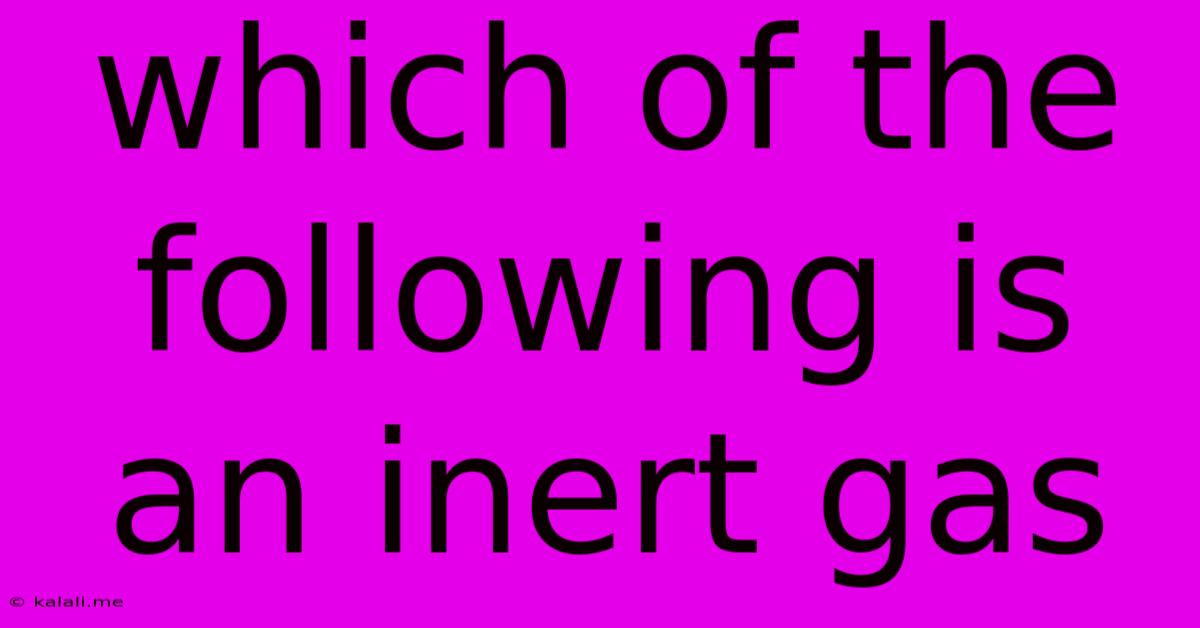Which Of The Following Is An Inert Gas
Kalali
Jun 14, 2025 · 3 min read

Table of Contents
Which of the Following is an Inert Gas? Understanding Noble Gases
This article explores the concept of inert gases, also known as noble gases, and clarifies which elements fall under this category. We'll delve into their unique properties and why they're considered unreactive. Understanding inert gases is crucial for various scientific fields, from chemistry and physics to atmospheric science and industrial applications.
What are Inert Gases?
Inert gases, or noble gases, are a group of chemical elements with similar properties. They are all odorless, colorless, monatomic gases with very low chemical reactivity. This low reactivity stems from their electronic structure: they have a full valence electron shell, meaning their outermost electron shell is completely filled. This stable electron configuration makes them extremely reluctant to participate in chemical reactions, hence their designation as "inert." The term "noble" is also used, reflecting their unwillingness to combine with other elements, similar to the aloofness historically associated with nobility.
The Noble Gas Family:
The noble gases include:
- Helium (He): The lightest noble gas, known for its use in balloons and cryogenics.
- Neon (Ne): Famous for its bright orange-red glow in neon lights.
- Argon (Ar): The most abundant noble gas in the Earth's atmosphere, used in welding and other industrial processes.
- Krypton (Kr): Used in some high-intensity lighting applications.
- Xenon (Xe): Used in certain types of lighting and also in medical imaging.
- Radon (Rn): A radioactive gas, occurring naturally as a decay product of radium. It is a significant health concern due to its radioactivity.
Why are they Inert? A Deeper Look at Electron Configuration:
The key to understanding the inertness of noble gases lies in their electron configuration. Atoms strive for stability, and the most stable configuration is having a full valence electron shell. Noble gases naturally possess this full shell, making them incredibly stable and unlikely to gain, lose, or share electrons with other atoms. This is the fundamental reason why they rarely form chemical compounds.
Exceptions to the Rule:
While the term "inert gas" implies complete lack of reactivity, it's important to note that this is a relative term. While extremely unreactive, xenon, krypton, and even radon can form compounds under specific, often extreme conditions, primarily with highly electronegative elements like fluorine and oxygen. These compounds are rare and typically require specialized synthesis techniques. However, the existence of these compounds highlights that even the most inert elements can participate in chemical reactions under the right circumstances.
Applications of Inert Gases:
The unique properties of noble gases lead to a variety of applications:
- Lighting: Neon and argon are used in lighting, providing distinct colors and brightness.
- Welding: Argon and helium are employed as shielding gases in welding to protect the weld from atmospheric contamination.
- Medicine: Xenon is used in medical imaging techniques.
- Cryogenics: Helium is used in cryogenic applications due to its extremely low boiling point.
In Conclusion:
All the elements listed above are indeed inert gases, or noble gases. Their inherent stability due to their complete valence electron shells is responsible for their low reactivity. While typically considered unreactive, some heavier noble gases can form compounds under specific conditions. Their unique properties make them valuable in diverse scientific and industrial applications. Understanding the properties and applications of noble gases is critical for advancements in various scientific and technological fields.
Latest Posts
Latest Posts
-
Deep Narrow Valley With Steep Sides
Jun 15, 2025
-
An Attitude Of Cultural Relativism Is
Jun 15, 2025
-
Does Kennesaw State Require Sat 2024
Jun 15, 2025
-
Relation Between Youngs Modulus And Shear Modulus
Jun 15, 2025
-
In What Organelle Is Dna Found
Jun 15, 2025
Related Post
Thank you for visiting our website which covers about Which Of The Following Is An Inert Gas . We hope the information provided has been useful to you. Feel free to contact us if you have any questions or need further assistance. See you next time and don't miss to bookmark.